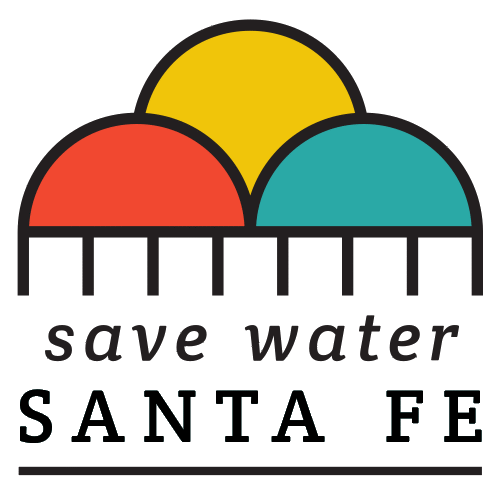Drought & Water Management in Santa Fe
The two Water Emergency Management stages have mandatory, stringent water-use restrictions that increase with the emergency and are focused mostly on outdoor use. The restrictions become effective immediately with the public announcement by the city manager of a water emergency. Water Warning – “Orange” begins when our water system can only supply 80-99 percent of operational water system demand. The restrictions are designed to prevent the crisis from deepening.
Water Warning – Orange
Landscape irrigation is limited to no more than twice a week with the days determined by whether the address is odd or even. Vehicle washing is discouraged but allowed but only with a shut-off nozzle. Ponds and fountains are allowed. One initial filling is allowed for both indoor and outdoor swimming pools and spas. Outdoor watering for parks, public schools, athletic fields and roadside landscaping is reduced by 35 percent.
Severe Outdoor Water Restrictions Water Crisis – “Red”
Water Crisis – “Red” begins when our water system can only supply less than 80 percent of operational water system demand and nearly all outdoor irrigation using potable (drinking water) is not allowed. Gray water use is not restricted. Significant landscape damage is likely. No landscape watering is allowed. Vehicle washing is prohibited. No ponds or fountains are allowed. Swimming pools and spas are prohibited. Parks, public schools, athletic fields and roadside landscaping will be watered enough to maintain the health of the plants, given evaporation of any moisture in the ground and the transpiration of water from plants.
City water managers constantly monitor for drought conditions and keep up-to-date on snowpack, reservoir levels and weather conditions. Drought or no drought, water conservation and drought awareness are cornerstones of the City’s comprehensive water planning approach.
How We Plan For and Manage Drought
Water conservation and drought awareness are cornerstones of the City’s comprehensive water planning approach, drought or no drought. City water resources staff monitor drought conditions and keep up-to-date on snowpack, reservoir levels and adverse water conditions and are prepared for severe drought and heat. Should drought conditions significantly worsen, the City can invoke strategies to provide short-term relief from temporary drought-related water supply shortages, including mandatory water restrictions for certain types of water use. Click here to see the 2020 Water Conservation Plan.
However, saving water is always in season in Santa Fe, in wet times and dry. Some restrictions on water use are always in place. To find out more about year-round requirements, click here.
Water Emergency Management Plan
In addition to year-round water use restrictions, the City’s primary drought management tool is the Emergency Water Regulations Ordinance adopted in 1996. This ordinance allows more severe water-use restrictions to be implemented as necessary to ensure that demand does not exceed sustainable, available supply and production capacity during times of drought. The Water Emergency Management Plan is Chapter 25, section 5, of the city code. Click to download Chapter 25 of the City Code.
The declaration of a water emergency is based on supply and demand data from the Water Division Director and the emergency restrictions primarily apply to outdoor water use.
Summer Watering Restrictions
Some restrictions are always in place: Yearly, from May 1 to October 31, it is illegal to water between 10 am and 6 pm, except under special circumstances. It’s also recommended that you only water up to three times a week. Click here, for more detail.
Water Emergency Stages
The two Water Emergency Management stages have mandatory, stringent water-use restrictions that increase with the emergency and are focused mostly on outdoor use. The restrictions become effective immediately with the public announcement by the city manager of a water emergency.Water Warning – “Orange” begins when our water system can only supply 80-99 percent of operational water system demand. The restrictions are designed to prevent the crisis from deepening.
Mandatory Outdoor Watering Restrictions:
Water Warning – “Orange”
- Landscape irrigation is limited to no more than twice a week with the days determined by whether the address is odd or even.
- Vehicle washing is discouraged but allowed but only with a shut-off nozzle.
- Ponds and fountains are allowed.
- One initial filling is allowed for both indoor and outdoor swimming pools and spas.
- Outdoor watering for parks, public schools, athletic fields and roadside landscaping is reduced by 35 percent.
Severe Outdoor Water Restrictions
Water Crisis – “Red”
Water Crisis – “Red” begins when our water system can only supply less than 80 percent of operational water system demand and nearly all outdoor irrigation using potable (drinking water) is not allowed. Gray water use is not restricted. Significant landscape damage is likely.
- No landscape watering is allowed.
- Vehicle washing is prohibited.
- No ponds or fountains are allowed.
- Swimming pools and spas are prohibited.
- Parks, public schools, athletic fields and roadside landscaping will be watered enough to maintain the health of the plants, given evaporation of any moisture in the ground and the transpiration of water from plants.
To download the City’s Water Conservation and Drought Management Plan, click here.
The NM Office of the State Engineer has an excellent gray water guide.
Climate Change—The New Normal?
The City of Santa Fe Water Division has the responsibility to prepare the municipal water utility for a range of conditions that might result from global climate changes like less mountain snowpack, earlier or reduced peak stream run-off flows, greater evaporation losses, more extreme weather events, and increased summer demand from hotter, drier, and longer summer season. To learn more about how the City is preparing for climate change, please click here and view the Climate Change Report.
Want to know more? Check out these quick links.
U.S. Drought Monitor
NM Governor’s Drought Task Force Planning
NM weather forecast, drought, climate and fire outlooks
